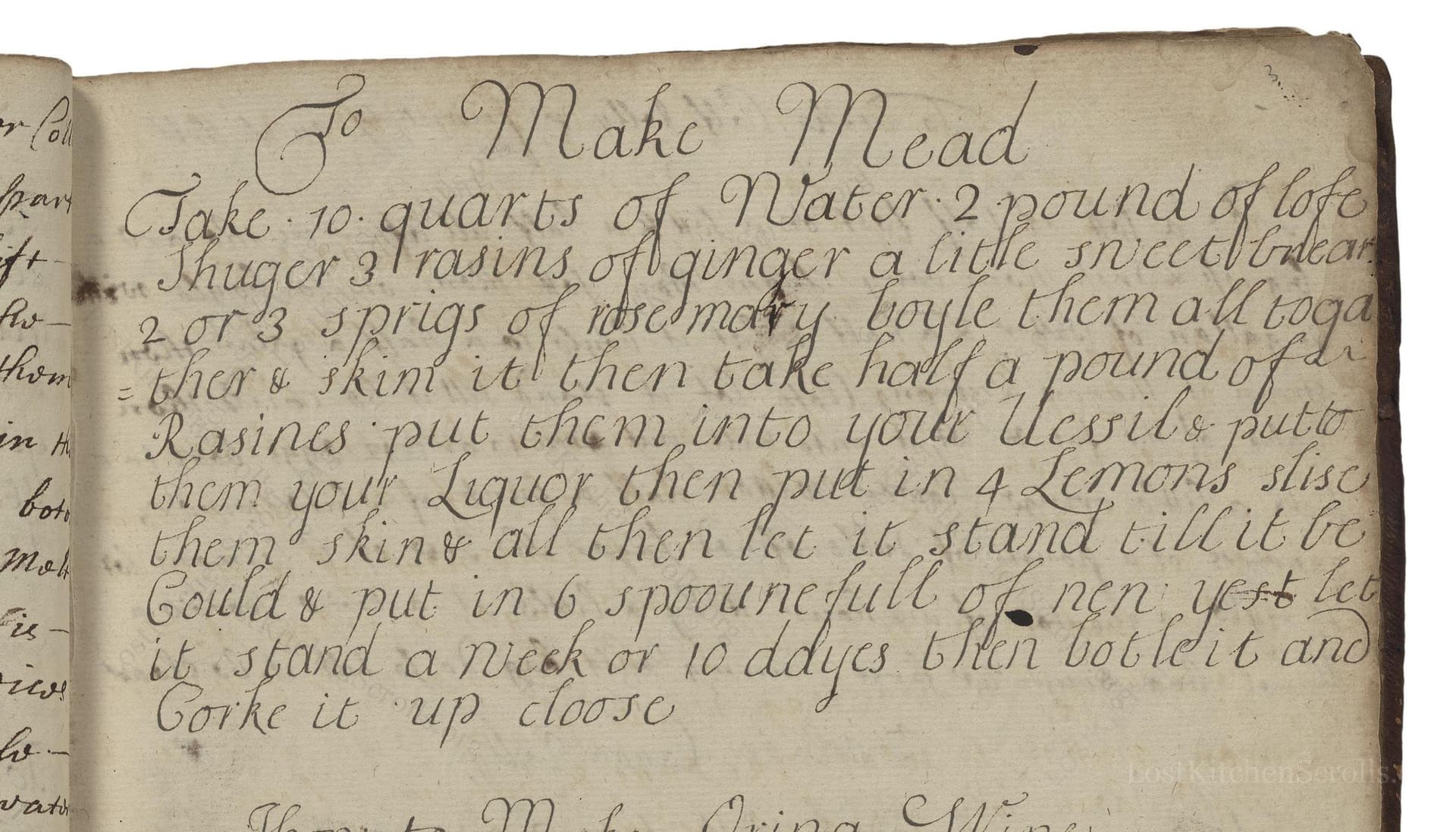To Make Mead
From the treasured pages of Mrs. Rachel Kirk Book 1707
Written by Rachel Kirk

To Make Mead
"Take 10 quarts of Water 2 pound of lofe Shuger 3 rasins of ginger a litle sweet brear 2 or 3 sprigs of rosemary boyle them all togather & skim it then take half a pound of dr Rasines put them in to your Vessill & putto them your Liquor then put in 4 Lemons slise them skin & all then let it stand till it be Could & put in 6 spoonfull of new yest let it stand a week or 10 dayes then botle it and Corke it up cloose"
Note on the Original Text
This recipe is written in the loose, narrative style of early modern English household manuscripts—heavy on the process, light on exact measurements and times. Spelling is highly variable and phonetic ('Shuger' for sugar, 'boyle' for boil, 'Could' for cool, 'yest' for yeast), reflecting both the period's lack of standardization and the author's dialect. Punctuation is sparse or missing, so instructions flow in long, continuous sentences, requiring the reader to interpret steps logically.

Title
Mrs. Rachel Kirk Book 1707 (1707)
You can also click the book image above to peruse the original tome
Writer
Rachel Kirk
Era
1707
Publisher
Unknown
Background
A remarkable collection of early 18th-century recipes, Rachel Kirk's work invites readers into the kitchens of the past where classic culinary traditions and timeless flavors come alive. Expect a charming medley of savory feasts and sweet treats reflective of the era's sophisticated palate.
Kindly made available by
Folger Shakespeare Library
This mead recipe is drawn from the manuscript cookbook of Rachel Kirk, dating to 1707. It reflects early 18th-century English household brewing, where mead held a special place as a convivial, mildly intoxicating beverage made from sugar, water, and aromatic herbs. At the time, mead could be flavored with herbs (like sweet briar and rosemary) and citrus to lend not only flavor, but supposed health benefits. The recipe pre-dates widespread commercial brewing and highlights the resourcefulness of home brew practices common in both town and countryside estates.

The original preparation would have required a large copper or earthenware brewing kettle for boiling the mixture over an open hearth or fire. A wooden spoon for skimming and stirring, a lidded ceramic or wooden brewing vessel (known as a 'vessell') for fermenting the mead, cloths or muslin for straining, and glass or stoneware bottles sealed with natural corks were typical. Measuring was done by eye or by household measures (quarts, pounds, spoonfuls).
Prep Time
20 mins
Cook Time
40 mins
Servings
20
We've done our best to adapt this historical recipe for modern kitchens, but some details may still need refinement. We warmly welcome feedback from fellow cooks and culinary historians — your insights support the entire community!
Ingredients
- 2.5 gallons water
- 2 pounds white sugar
- 3 pieces (approx. 2-inch each) fresh ginger root
- 1/3 ounce dried rosehips (substitute for sweet briar)
- 2–3 sprigs fresh rosemary
- 8 ounces dried raisins
- 4 lemons, sliced (with skin)
- 6 tablespoons (3 fl oz) fresh baker's yeast
Instructions
- To make a historical mead in a modern kitchen, begin by measuring 2.5 gallons of water and placing it in a large stockpot.
- Add 2 pounds of white sugar, three pieces (approx.
- 2-inch) of fresh ginger root, a small handful (about 1/3 ounce) of sweet briar (use dried rosehips as a substitute), and 2–3 sprigs of fresh rosemary.
- Bring the mixture to a gentle boil, skimming any foam from the surface as it appears.
- Once simmering, add in 8 ounces of dried raisins and stir briefly.
- Pour the hot liquid into a fermentation vessel over the raisins.
- Slice four whole lemons (with skin), remove any seeds if desired, and add to the vessel.
- Allow the mixture to cool to room temperature.
- When cool, stir in 6 tablespoons (about 3 fluid ounces) of fresh baker's yeast.
- Cover and let it ferment for 7–10 days, then strain, bottle the mead, and seal tightly.
Estimated Calories
150 per serving
Cooking Estimates
It takes about 20 minutes to prepare the ingredients and 40 minutes to simmer the mixture. Each serving contains roughly 150 calories, assuming the final mead is divided into 20 glasses. These estimates help you plan your time and know what to expect for each serving.
As noted above, we have made our best effort to translate and adapt this historical recipe for modern kitchens, taking into account ingredients nowadays, cooking techniques, measurements, and so on. However, historical recipes often contain assumptions that require interpretation.
We'd love for anyone to help improve these adaptations. Community contributions are highly welcome. If you have suggestions, corrections, or cooking tips based on your experience with this recipe, please share them below.
Join the Discussion
Rate This Recipe
Dietary Preference

Den Bockfisch In Einer Fleisch Suppen Zu Kochen
This recipe hails from a German manuscript cookbook compiled in 1696, a time whe...

Die Grieß Nudlen Zumachen
This recipe comes from a rather mysterious manuscript cookbook, penned anonymous...

Ein Boudain
This recipe comes from an anonymous German-language manuscript cookbook from 169...

Ein Gesaltzen Citroni
This recipe, dating from 1696, comes from an extensive anonymous German cookbook...
Browse our complete collection of time-honored recipes



